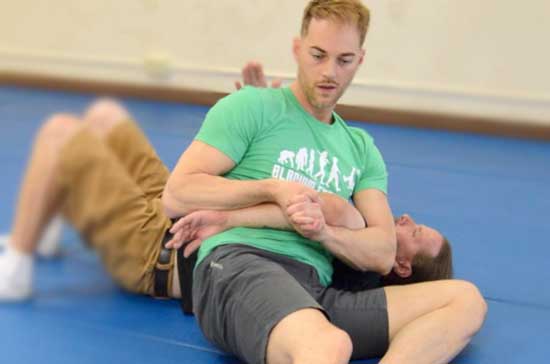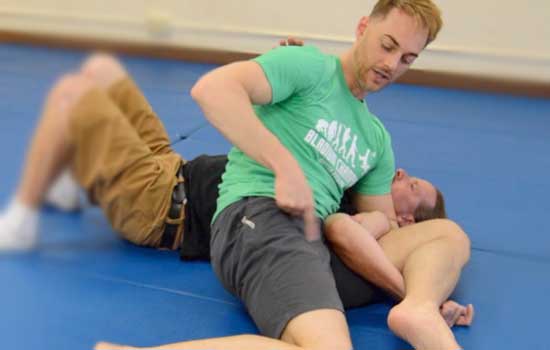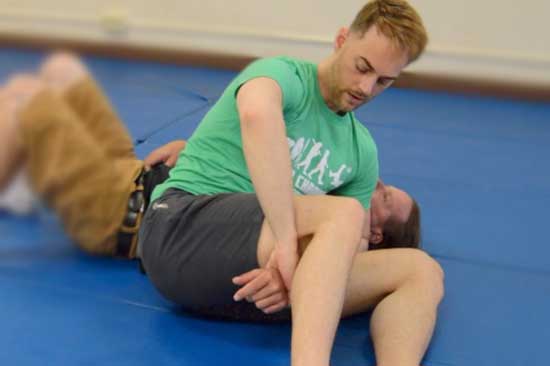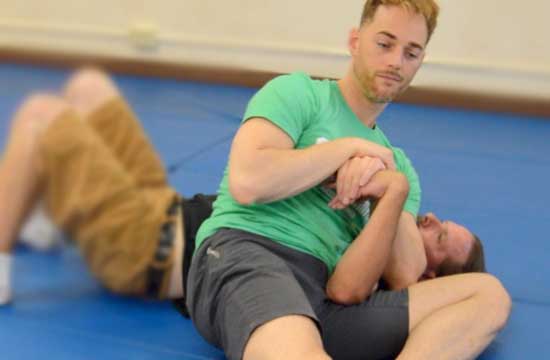Joint locks and joint wrenches from the scarf hold are bad-arse. Enjoy!
Joint locks and joint wrenches can be effective if you know how to get them quickly and understand when to use them.
In my previous video I showed you how to get the scarf hold, escape it, and do quick terminations. You can read that article and watch that video here. Scarf Hold part 1
In today’s video I will teach you how to get 4 different joint locks and joint wrenches from the scarf hold position.
Joint Locks vs. Joint Wrenches
A joint lock is simply taking a joint to its end range of motion and then applying additional slow pressure to make it go further. This creates pain in the owner of said joint for obvious reasons.
In sports such as Brazilian Jujitsu, Judo, MMA, and more they are used to force an opponent to submit or tap out. More on that later.
A joint wrench also takes a joint to its end range of motion but instead of applying slow steady pressure you violently drive force to make the joint go further than it anatomically can. This injures the joint by damaging the connective tissues. This would be a pretty crappy thing to do in a sport as it will require extensive rehab in a lot of cases to recover from. More on that later.
Since a joint lock and a joint wrench are the same except for how fast you apply the pressure every joint lock I teach from this point forward is also a joint wrench if done quickly and violently.
Do to the complexities of instruction and the sheer number of images I would need to be able to effectively teach all of these joint locks I will instead summarize key bullet points to effectively get these 4 joint locks. For the detailed step-by-step watch the video.
Here we go.
Practicing Joint Locks Safely
Oh wait… I presume you will be practicing these joint locks with someone you like. Please go very slow and be careful. The person in the joint lock should not fight and resist to be ‘tough’ as that will result in possible injury and surely achy pissed of joints.
A good rule of thumb is as soon as you feel the lock is set and before you feel pain go ahead and tap your partner with your free hand or have a stop word such as “break!”
You and your training partner’s joints will thank me.
Joint Lock #1 – Internal Shoulder Lock
If you take your arm out to your side, bend your elbow 90° and then internally rotate your shoulder as far as you can that is an internal shoulder joint lock.

To make your opponent’s shoulder internally rotate to its full end range of motion follow these key pointers:
- Your opponent’s wrist needs to move down towards the ground. You can use your armpit or if needed your elbow to push it down as seen in the image above.
- You must pull your opponent’s elbow up towards the ceiling. I use my radial bone near the wrist to hook underneath, clasp my hands and then use both arms to drive it.
- If your lock isn’t working it is probably because you are allowing their shoulder to rise up which will increase their range of motion thus foiling your joint lock. So put your weight on top of their shoulder to keep it down.
- Rotate your hips and legs towards their head to really crank this up. Just be sure to look out for the common escapes from the previous scarf hold video such as a leg around your head.
Joint Lock #2 – External Shoulder Lock
If you take your arm out to your side, bend your elbow 90° and then externally rotate your shoulder as far as you can that is an external shoulder joint lock.

The tips from the internal shoulder lock will apply but we will use our leg this time to get the lock. This leaves your hands free to do other things like crocheting, basket weaving, or elbowing them in their face unit:
- Grab their wrist and bend their arm back as seen in the image.
- Now stack your ankle on top of their wrist… please be careful with your partner in case they have tight shoulders.
- Now press their wrist all the way to the ground while raising their elbow with your hips.
- Keep your weight on their shoulder so they can’t absorb the joint lock with scapular protraction.
- If you need additional help getting the joint lock you can use your free hand to push on their elbow.
Joint Lock #3 – Elbow Lock
This is simply a hyperextension of the elbow joint.

This is a cool lock and is pretty darn easy… well actually all of them are if you train them enough.
Your thigh goes under their elbow while your other thigh pushes down on their wrist which puts them into elbow hyperextension. Follow these tips to ensure it works:
- Keep your knee / thigh that is under their elbow high so that it is contacting their elbow above (proximal) to the elbow joint. Your thigh should be right on their triceps tendon. If you are distal or on the forearm side of their elbow there won’t be any lock.
- Stack your top thigh down on top of their wrist and apply pressure down towards the ground.
- Now this is key. Think of the direction that the elbow bends. You must be applying pressure in the same direction or the lock won’t work. You might have to watch the video to get what I’m saying here. But you can always look at the top of their elbow and make sure that the inner part of their elbow is pointed towards the ceiling. If it isn’t then grab their wrist as you see me doing in the image above and turn it until it points up.
- As always keep your weight on their shoulder so they can’t raise their scapula to take pressure off of the lock.
Joint Lock #4 – Wrist Flexion Lock
This joint lock is rarely taught and easy to get. If you were to rest your elbow on a desk with your forearm vertical then flex your wrist as seen in the image and push down on your knuckles with your free hand you will get the idea of this joint lock.

Follow these tips to get the lock:
- Often I go for this lock when my training partner is trying to keep me from getting another lock. They flex their arm and I say “thank you”.
- Just have their elbow on top of your thigh as if you were going for an elbow lock or the external shoulder lock.
- Now reach up and put your palms on top of their knuckles and push them down towards the floor.
- If this isn’t working you might be applying pressure too close to their wrist so slide your hands down on top of their knuckles.
Joint Locks in the Street
So look here is the deal. I get kinda quirked at most martial arts gyms because they teach how to kick, or punch, or joint lock, or how to carry 13 knives and cut every artery in the human body… but they don’t teach when you should or should NOT do those things.
Prison, the hospital, a courtroom, and the morgue are all places I’d prefer to avoid.
Let’s talk about how you can avoid those places too.
Let’s say you get into a barroom altercation with a gentleman and you slip on a spilled long island ice tea and find yourself on the ground.
No worries you use your double overhooks (from a previous video), shrimp to a shin guard and roll them to a scarf hold (learned from this video). And then apply an armlock.
Now what?
They tap out and you let them up and they start throwing punches again?
Ok cool well let’s just arm wrench them instead. They won’t be throwing punches with a busted up shoulder, elbow, or wrist.
Great the fight is probably over but you just caused potentially significant bodily damage to some drunk a-hole.
That means you might have to convince a police officer, prosecutor, judge, and jury that you did it in self-defense rather than mutual combat.
More so you will have to prove that going to that level of force was necessary.
“Awe man Brian why do you gotta make us worry about that?”
Better to worry about it in training than to spend a year of your life and $50,000 of your money defending your right to stay out of jail.
But wait there is more…
Even if criminal charges aren’t pressed you might be sued for their medical bills and end up paying a percentage of them. Yeah… for real.
So here are some ideas on when you might use joint locks and wrenches in the real world outside of the gym:
Joint Locks
These can be used in situations where it is safe to stay on the ground. Where you don’t want to hurt someone but need to detain them until help arrives.
These can be great when a friend of a friend gets too drunk and acts like a damn fool at a New Year’s Party… don’t ask. You hold them until their friend comes to take them away or until the police arrive. Please don’t crank the joint lock the entire time. Put it on and leave it without pressure. Apply pressure as a tool to get them to comply. Complying means chilling out. Pain can be a good method of getting people to comply.
In law enforcement? Gotta huge PCP’d out psycho who is too much trouble to arrest on your own? Worse yet did you wind up on the ground with him?
Cool lock them up. They may or may not care about the pain but they aren’t going anywhere. Now additional officers can arrive and you can move to cuffing.
If they start hitting, clawing, biting, then transition to elbows to the head to knock them out.
Joint Wrenches
Since these can cause injuries save them for higher threat situations. If you wind up on the ground with someone that is bigger, stronger, or quite dangerous for some other reason and intends to do severe harm to you then wrenches are on the table folks.
In multiple attacker scenarios you always want to get up ASAP so it is usually better to terminate with quick elbows than to fool around trying to get a joint wrench. But if it is there… go for it.
Final Thoughts
Joint locks and wrenches should be understood by all martial artists, self-defense types, LEOs, security, and anyone that needs to control other people. Oh and of course sport fighters if joint locks are allowed.
For some such as LEOs joint locks can be an essential tool. For others such as people interested in self-defense it is an optional tool for your tool belt.
Until next time,
Brian



